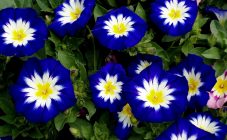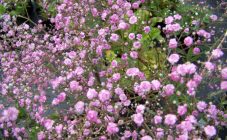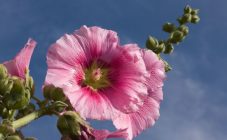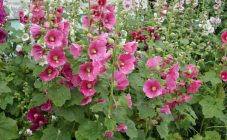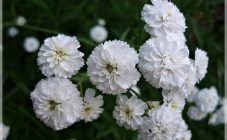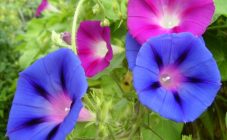Content:
Perennial rudbeckia is a very beautiful plant that is popular with many gardeners. And it is not surprising, because in rainy autumn weather, it is it that will remind you of sunny warm days with its flowers, similar to small suns. Also, rudbeckia is loved for its ease of care and unpretentiousness.
From the history
Rudbeckia (Rudbeckia) is a plant that belongs to the genus Herbaceous and the family Astroceae. There are annual, biennial and perennial representatives of this culture. There are about 40 species in total. The homeland is considered to be North America, where rudbeckia is still found in huge quantities on the prairies today. When the first settlers appeared on the territory of North America, they called the flower "black-eyed Suzanne"; after the appearance of Europeans, it was called "sun hat".
The plant got its current name in honor of the Swiss botanists - the father and son of the Rudbeks. Today rudbeckia is common in many countries of Europe and Africa as a decorative perennial or annual culture.
Description
The big advantage of rudbeckia is that even before flowering, the bush of this plant is of high decorative value. The height of the bushes depends on the variety and can be from 0.5 to 2.5 meters. Some species even reach 3 meters. The stems are straight or branched.
The leaves are whole, from 5 to 20 cm. In the lower part of the plant, they are located on cuttings, and in the upper part, they are sessile. Depending on the variety, they can be different: oval, whole, pinnately dissected, ovoid, pinnately split.
Inflorescences are represented by baskets (about 15 cm), which are framed by petals. Their color can be very different, ranging from traditional yellow to purple-black.
After flowering, fruits are formed in the form of an oblong achene, which in some cases is framed by a small crown. The seeds are dark gray and small in size.
The main types of plants
Rudbeckia is divided into an annual (biennial) plant and a perennial. Each of them is represented by a large number of species. Some of them are found naturally, others are intended for cultivation in home gardens or in pots at home. The most common and popular varieties should be considered.
Rudbeckia is beautiful or beautiful
A perennial that reaches 50-60 cm in height, with elongated slightly rounded leaves. Jagged edges with irregularities. The flowers are bright orange. It is mainly found in the moist soils of North America.
Rudbeckia brilliant
Perennial, which reaches a height of 60 cm, while it is distinguished by solid, narrow lanceolate leaves.The inflorescences reach 9 cm and consist of orange or dark red tubular flowers. In nature, there are varieties of rudbeckia Hirta, Goldstar, Goldsturm, which have golden flower petals and a brown core.
Rudbeckia dissected
This plant grows up to 2 meters in height. Rudbeckia dissected is distinguished by a highly branched horizontal rhizome. The powerful stems have pinnately-divided leaves. The inflorescence has a diameter of 10 cm, it consists of 1-3 bright yellow flowers.
Dwarf species
This is a small dwarf plant, which does not exceed 30 cm in height. Most often, dwarf rudbeckia is used for growing on curb beds, in indoor pots or on balconies and loggias. Flower color (diameter - up to 10 cm) can be varied: from yellow to purple-black.
Rudbeckia terry or hairy
A separate type of rudbeckia, which combines many varieties. The color can be varied. There is white, blue, red, yellow rudbeckia. Shoots up to 1 meter high. The plant lives no more than 2 years and reproduces by flowers. This species is distinguished by the presence of hard nap on foliage and shoots.
The inflorescences of the basket abundantly cover the bushes during the flowering period. The diameter of the flowers is about 10 cm.
Rudbeckia hybrid
This is a large group that combines hybrids of various varieties of a garden plant (hairy, glossy and spreading). Stems are tough, leafy, reaching a height of 70 cm. The upper leaves sit on the stem, the lower ones grow on petioles. Hybrid rudbeckia is distinguished by rather large inflorescences, the diameter of which reaches 19 cm. The petals of flowers resemble tongues in shape, most often they are yellow, sometimes yellow-brown representatives are found. The fruit is a small achene in which dark black shiny seeds are located.
The best varieties of perennial rudbeckia
Today, there are a huge number of varieties of this plant on sale. Each of them is worthy of attention, but still it is worth highlighting the most popular:
- Rudbeckia Cappuccino is a hairy species. The cappuccino is distinguished by a straight, slightly branched stem, on which inflorescences about 8 cm are formed. The tubular flowers are colored coffee-red, and the lingual flowers have an orange-yellow tint. Differs in abundant flowering until late autumn. Planting and leaving Rudbeckia Cappuccino is not much different from other representatives of similar flowers.
- The Marmalade variety belongs to the Asteraceae family. A huge number of inflorescences are formed during the season. The flowers are very large, leafy platinum seems to float above the core and are densely covered with hairs.
- Rudbeckia shaggy Mareno is a perennial herb that has dark red flowers. Differs in relatively early flowering from July to October.
- Rudbeckia Amber. Medium-sized plant, up to 60 cm, with good drought tolerance. The flowers are golden yellow. The diameter of the inflorescences is about 10 cm.
- Rudbeckia Golden ball has been very common since ancient times. It is a perennial plant that grows to a height of 2.5 meters. The flowers are shaggy and resemble a small beautiful yellow ball. It is popular because of its unpretentiousness and resistance to diseases.
- Rudbeckia purple. This cultivar is a very close relative of Echinacea. Powerful shoots reach a height of 1 m. The first inflorescences appear in mid-July, in colder regions - in early August. The flower can be up to 10 cm in diameter.
- Rudbeckia Cherry Brandy. Rudbeckia stems of this variety are about 0.5 meters high. The flowers of the plant are cherry-colored with a dark burgundy color. They look great in flower beds and are used in landscape design.There is also an annual or perennial cherry brandy rudbeckia.
- Rudbeckia Toto belongs to the hairy variety. This is a dwarf bush, the height of which does not exceed 30 cm. It looks good in border compositions and other flower beds.
- Another popular undersized variety is the brilliant Goldsturm rudbeckia, whose flowers are yellow with a dark core. Rudbeckia variety Goldsturm perfectly tolerates weather changes and pleases with beautiful flowers for a long time.
- One of the most common hybrids is Gloria Daisy, whose height does not exceed 70 cm. The initial plant for selection was hairy rudbeckia. Differs in abundant flowering, is capable of self-seeding.
Landing
You can plant rudbeckia by growing seedlings or by sowing in open ground. In the latter case, seeds are sown in May, in colder regions in early June. By autumn, the plant will rise, and it will be possible to plant seedlings in a permanent place. If the planting takes place immediately to a permanent place, then next year you can expect abundant flowering.
You can also sow seeds and seedlings at home. Sowing is carried out in April. At the end of May, it will already be possible to plant seedlings in the beds.
Care features
Rudbeckia does not belong to capricious crops, therefore, for its good growth, simple agricultural techniques are enough:
- Timely watering. The plant loves sunny places, so it is important to monitor the condition of the soil. The occurrence of a period of slight drought will not affect the bushes. During the period of active growth, watering is intensified, this will help to get more abundant flowering.
- Pruning. To ensure abundant and long-lasting flowering, it is required to regularly prune dry inflorescences. For the winter, the bushes are cut off completely, additionally covering them from frost with spruce branches and dry foliage.
- Top dressing. For active growth, it is enough to feed the flower twice a season. For the first time, complex mineral fertilizers are applied (1 tablespoon of Agricola is diluted in a bucket of water and about 3 liters of solution is poured under each bush) in early spring to help form a powerful root system. The second feeding is performed after 20 days. The following composition would be an ideal option: for 10 liters of water, 1 tbsp is taken. l. nitrophosphate and finished Ross fertilizer. Consumption - 3 liters for a bush.
Reproduction
In addition to sowing with seeds, you can use the method of dividing the bushes for propagation. It is recommended to carry out division every 5-6 years. The old bush is dug up and divided into parts. Then the new plants are planted at a distance.
Diseases and pests
The advantage of rudbeckia is its high immunity to diseases and pests. In rare cases, it is possible to encounter powdery mildew when growing such flowers. When a white coating appears in the form of specks of flour, measures should be taken: treat with a 1% solution of colloidal sulfur. It is also advisable to use copper sulfate for treatment. Add 80 grams to a bucket of water. facilities.
There are cases of leaf nematode damage. Its appearance will be signaled by brown spots on the leaves, which, if untreated, die off. The treatment is carried out with special preparations. If the treatment did not save, then all damaged areas are removed and burned.
The foliage of small shrubs should be checked periodically for leaf-eating insects.
Rudbeckia is a perennial flower that will become a worthy decoration of an alpine slide and flower bed. They love her very much because she retains her attractive original appearance in bouquets for a long time.








